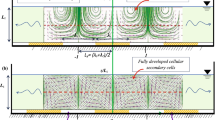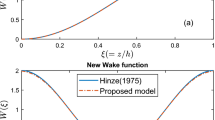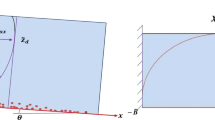Abstract
Abstract
Turbulence induced secondary currents are commonly present in straight natural as well as artificial open-channels. Different structures of cellular secondary currents can be seen in open-channel flows due to various bed configurations. In our study, mathematical models of turbulence-induced secondary currents in the vertical and transverse directions within a straight open rectangular channel with alternate rough and smooth longitudinal bed strips are proposed. The proposed models are derived using theoretical and mathematical analysis with appropriate boundary condition. Most of the previous models of secondary currents in the literature are proposed empirically and without proper mathematical derivation including effects of fluid viscosity and eddy diffusivity. The inclusion of these effects make the present study more practical. Initially the governing equation for vertical secondary flow velocity is derived from continuity and the Reynolds-Averaged Navier Stokes equations. Then, the proposed problem is divided into two sub-considerations, corresponding to the base flow and perturbed flow. Finally, these sub-problems are analytically solved using method of separation of variables with suitable boundary conditions. Different models to consider two different types of bed-roughness configurations (i.e. equal and unequal lengths of smooth and rough longitudinal bed strips) are obtained. Apart from velocity formulations, models of the stream function are proposed for these two types of bed configurations. All proposed models are validated using existing experimental data for the various bed configurations in open-channel flows and satisfactory results have been obtained. These present models are also compared with empirical models from the literature and they are found to be more effective in representing both types of bed-roughness configurations. The effects of bed configuration on the streamlines of settling velocity are also investigated. Results show that laterally-skewed secondary cells (which occurs due to unequal smooth and rough bed strips), have significant effects on the closed \(\omega\)-streamlines in terms of shape and location of the center of these closed streamlines. More precisely, it is found that the area of the downflow zone proportionally increases with the length of rough-bed strips.
Article highlights
-
Complete analytical models of secondary flow velocities and stream functions along vertical and transverse directions are proposed.
-
Under two different bed configurations, models gives satisfactory results.
-
Area of the downflow zone proportionally increases with the length of rough bed strips which significantly influence particle settlement.













Similar content being viewed by others
Availability of data and materials
All data used in this study is electronically available.
Abbreviations
- B :
-
Channel width (m)
- \(C_1\) :
-
Parameter
- Er :
-
Absolute error value
- g :
-
Gravitational acceleration (m/s)
- h :
-
Flow height (m)
- J :
-
Slope of the channel
- K :
-
Some constant
- \(K_b\) :
-
Amplitude of perturbation
- M :
-
Parameter [=\((4\tilde{\overline{\nu }}_t)/\varLambda\)]
- MKE :
-
Mean Kinetic Energy
- N :
-
Total number of data points
- P :
-
Pressure
- \(PS(\tilde{y})\) :
-
Sinusoidal function
- \(PC(\tilde{y})\) :
-
Derivative of \(PS(\tilde{y})\)
- p, q, r :
-
Mean velocity components along x, y and z directions
- \(p',q',r'\) :
-
Fluctuating velocity components
- RANS:
-
Reynolds-averaged Navier-Stokes equation
- \(\tilde{r}_1\) :
-
Idealized secondary flow
- \(\tilde{r}_2\) :
-
Perturbed flow related to bed configuration
- S50, S75:
-
Run numbers of [48] experiment
- SC:
-
Secondary current
- \(U_m\) :
-
Mean value of primary flow
- \(u_*\) :
-
Shear velocity
- \(\overline{u_*}\) :
-
Averaged shear velocity
- \(v_{observe}\) :
-
Observed value
- \(v_{computed}\) :
-
Observed value
- \(W_{max}\) :
-
Maximum upwelling velocity (m/s)
- \(\widetilde{W}_{max}\) :
-
Dimensionless maximum upwelling velocity (m/s)
- x, y, z :
-
Streamwise, longitudianl and vertical co-ordinates respectively
- \(\tilde{x}, \tilde{y}, \tilde{z}\) :
-
Dimensionless co-ordinates
- \(z_0\) :
-
Zero velocity level (main velocity)
- \(\tilde{z}_0\) :
-
Dimensionless zero velocity level
- \(\alpha\) :
-
Dip correction parameter
- \(\alpha _0\) :
-
Empirical constant
- \(\varTheta\) :
-
Coefficient [=\(\tilde{\nu } +\tilde{\nu }_t\)]
- \(\kappa\) :
-
von Karman constant \((\approx 0.4)\)
- \(\varLambda\) :
-
Coefficient [=\(2(\tilde{\nu } -\tilde{\nu }_t)\)]
- \(\lambda\) :
-
Average width of the strips
- \(\lambda _{dn}, \lambda _{up}\) :
-
Widths of down-flow and up-flow zones
- \(\lambda _r\) :
-
Length of rough bed-strip
- \(\lambda _s\) :
-
Length of smooth bed-strip
- \(\nu\) :
-
Kinematic viscosity
- \(\nu _t\) :
-
Turbulent eddy viscosity
- \(\tilde{\nu }_t\) :
-
Dimensionless turbulent eddy viscosity
- \(\bar{\nu }_t\) :
-
Depth-averaged eddy viscosity
- \(\varPi\) :
-
Cole’s wake parameter \((\approx 0.19)\)
- \(\rho\) :
-
Density of fluid
- \(\tau _b\) :
-
Local bed shear stress
- \(\bar{\tau _b}\) :
-
Average bed shear stress [=\(\rho \overline{u}^2_*\) ]
- \(\varphi\) :
-
A function of y and z
- \(\psi\) :
-
Stream function
- \(\tilde{\psi }\) :
-
Dimensionless stream function
- \(\varOmega\) :
-
Vorticity vector
- \(\omega _0\) :
-
Particle settling velocity in still fluid
- \(\overrightarrow{\omega _s}\) :
-
Settling velocity vector
- \(\nabla\) :
-
Laplacian operator
References
Allen J (1985) Principles of physical sedimentology. Chapman & Hall, London
Andersen KH (1999) The dynamics of ripples beneath surface waves and topics in shell models of turbulence. Ph.D. thesis, Univ. of Copenhagen, Copenhagen, Denmark
Ardiçlioǧlu M, Kuriqi A (2019) Calibration of channel roughness in intermittent rivers using hec-ras model: case of sarimsakli creek, turkey. SN Appl Sci 1:1080
Bradshaw P (1987) Turbulent secondary flows. Annu Rev Fluid Mech 19:53–74. https://doi.org/10.1146/annurev.fl.19.010187.000413
Brundrett E, Baines WD (1964) The production and diffusion of vorticity in duct flow. J Fluid Mech 19:375–394
Coleman J (1969) Brahmaputra river; channel process and sedimentation. Sed Geol 3:129–239
Coleman N (1981) Velocity profiles with suspended sediment. J Hydraul Res 19(3):211–229
Colombini M (1993) Turbulence driven secondary flows and the formation of sand ridges. J Fluid Mech 254:701–719
Demuren AO, Rodi W (1984) Calculation of turbulence-driven secondary motion in non-circular ducts. J Fluid Mech 140:189–222
Einstein HA, Li H (1958) Secondary currents in straight channels. Trans Am Geophy 39:1085–1088
Francis J (1878) On the cause of the maximum velocity of water flowing in open channels being below the surface. Trans Am Soc Civ Eng 7(1):109–113
Gessner F (1973) The origin of secondary flow in turbulent flow along a corner. J Fluid Mech 58:1–25
Gessner FB, Emery AF (1981) The numerical prediction of developing turbulent flow in rectangular ducts. J Fluid Eng ASME 103:445–454
Gibson A (1909) On the depression of the filament of maximum velocity in a stream flowing through an open channel. Proc R Soc A Math Phys Sci 82:149–159
Guo J (1998) Turbulent velocity profile in clear water and sediment-laden flows. Ph.D. thesis, Colorado State University, Fort Collins, CO
Guo J (2006) Self-similarity of mean flow in pipe turbulence. In: 36th AIAA fluid dynamics conferences and exhibit. AIAA paper 2885, San Francisco, CA
Hinze JO (1967) Secondary currents in wall turbulence. Phys Fluids 10:S122–S125
Ikeda S (1981) Self forced straight channels in sandy beds. J Hydraul Div 107(4):389–406
Karcz I (1981) Reflections on the origin of small scale longitudinal streambed scours. In: M. Morisawa (ed.) Fluvial geomorphology: A proceedings of the Foruth annual geomorphology symposia series, pp 149–177. Allen and Unwin, London
Kim H, O’Connor BA, Kim TH, Williams JJ (2000) Suspended sediment concentration over ripples. In: Proc., 25th int. conf. on coastal engineering, pp 2873–2885. ASCE, Reston, VA
Kinoshita R (1967) An analysis of the movement of flood waters by aerial photography; concerning characteristics of turbulence and surface. Photogr Surv 6:1–17 (in Japanese)
Kotsovinos NE (1988) Secondary currents in straight wide channels. Appl Math Modell 12:22–24
Kundu S, Ghoshal K (2012) An analytical model for velocity distribution and dip-phenomenon in uniform open channel flows. Int J Fluid Mech Res 39(5):381–395
Kundu S, Ghoshal K (2014) Effects of secondary current and stratification on suspension concentration in an open channel flow. Environ Fluid Mech 14:1357–1380
Lu J, Zhou Y, Zhu Y, Xia J, Wei L (2018) Improved formulae of velocity distributions along the vertical and transverse directions in natural rivers with the sidewall effect. Environ Fluid Mech 18(11):1491–1508
McLean SR (1981) The role of non-uniform roughness in the formation of sand ribbons. Mar Geol 42:49–74
Nezu I, Nakagawa H (1993) Turbulence in open channel flows. In: Balkema AA (ed) IAHR Monograph. https://doi.org/10.1201/9780203734902
Nakagawa H, Nezu I, Tominaga A (1981) Turbulent structure with and without cellular secondary currents over various bed configurations. Tech. Rep. 24B, Annuals, Disaster Prevention Research Institute, Kyoto University
Nezu I, Nakagawa H (1984) Cellular secondary currents in straight conduit. J Hydraul Eng 110:173–193
Nezu I, Nakagawa H, Kawashima N (1988) Cellular secondary currents and sand ribbons in fluvial channel flows. In: Proceedings of the 6th congress APD-IAHR, vol 2, pp 51–58. Madrid
Nezu I, Rodi W (1985) Experimental study on secondary currents in open channel flow. In: 21th IAHR Congress, pp 115–119. IAHR, Melbourne
Nezu I, Tominaga A, Nakagawa H (1993) Field measurements of secondary currents in straight rivers. J Hydraul Eng 119(5):598–614
Nikora V, Roy A (2012) Secondary flows in rivers: theoretical framework, recent advances, and current challenges. Wiley, Hoboken, pp 1–22
Prandtl L (1926) \(\ddot{U}\)ber die ausgebildete turbulenz. In: 2e internationaler kongress der technischen mechanik, Verhandlung. F\(\ddot{u}\)essli, Z\(\ddot{u}\)rich
Proust S, Nikora V (2020) Compound open-channel flows: effect of transverse current on the flow structure. J Fluid Mech 885(A24):1–38
Pu JH (2015) Turbulence modelling of shallow water flows using kolmogorov approach. Comput Fluids 115:66–74
Pu JH, Shao S, Huang Y (2014) Numerical and experimental turbulence studies on shallow open channel flows. J Hydro-environ Res 8:9–19
Soualmia A, Zaouali S, Labiod C (2008) Modeling of secondary motions driven by the turbulence anisotropy in closed and open channels. Leban Sci J 9(2):75–89
Stearns F (1883) On the current-meter: together with a reason why the maximum velocity of water flowing in open channel is below the surface. Trans Am Soc Civ Eng 12(1):301–338
Studerus X (1982) Sekund\(\ddot{a}\)rstr\(\ddot{o}\)mungen im offenen gerrinne \(\ddot{u}\)ber rauhen l\(\ddot{a}\)ngsstreifen. Ph.D. thesis, Institut f\(\ddot{u}\)r Hydromechanik und Wasserwirtschaft, ETH, Z\(\ddot{u}\)rich, Switzerkland
Thomson J (1876) On the origin of windings of rivers in alluvial plains, with remarks on the flow of water round bends in pipes. Proc R Soc Lond 25:5–8
Tominaga A, Nezu I, Ezaki K, Nakagawa H (1989) Three-dimensional turbulent structure in straight open channel flows. J Hydraul Res 27(1):149–173
Townsend AA (1961) Equilibrium layers and wall turbulence. J Fluid Mech 11:97–120
Tracy H (1965) Turbulent flow in a three dimensional channel. J Hydraul Div ASCE 6:9–35
Tsujimoto T (1989) Longitudinal stripes of alternate sorting due to cellular secondary currents. In: Proc., 23rd IAHR congress, National Research Council of Canada, pp 17–25. Ottawa
Vanoni V (1946) Transportation of suspended sediment by running water. Trans ASCE 111:67–133
Wang Z, Cheng N (2005) Secondary flows over artificial bed strips. Adv Water Resour 28(5):441–450
Wang Z, Cheng N (2006) Time-mean structure of secondary flows in open channel with longitudinal bedforms. Adv Water Resour 29(11):1634–1649
Wang Z, Cheng N (2008) Influence of secondary flow on distribution of suspended sediment concentration. J Hydraul Res 46(4):548–552
Yang S, Tan S, Lim S (2004) Velocity distribution and dip-phenomenon in smooth uniform open channel flows. J Hydraul Eng 130(12):1179–1186
Yang SQ, McCorquodale JA (2004) Determination of boundary shear stress and reynolds shear stress in smooth rectangular channel flows. J Hydraul Eng 130(5):458–462
Acknowledgements
Authors are very much thankful to the Associate Editor Dr. Eric Pardyjak and the Reviewers for their fruitful and constructive comments which improves the manuscript.
Funding
Not Applicable.
Author information
Authors and Affiliations
Contributions
Dr. K originally formulated the idea of the work and derived the model with solution methods. Ms. C contributed to the preliminary concept of the study under the supervision of Dr. K. Dr. P modified and gave comments of the model. Afterward, Ms. C derived the preliminary solutions and Dr. K modified and corrected them. Ms. C completes the data analysis, modeling, programming and fitting parts and prepared the initial draft of the paper. Dr. K and Dr. P edited, revised and completed the final draft. Finally, all authors approved the final version.
Corresponding author
Ethics declarations
Conflict of interest
Authors declare that they do not have any conflict of interest.
Code availability
Not Applicable.
Ethics approval
Not Applicable.
Consent to participate
Not Applicable.
Consent for publication
Not Applicable.
Additional information
Publisher's Note
Springer Nature remains neutral with regard to jurisdictional claims in published maps and institutional affiliations.
Rights and permissions
About this article
Cite this article
Kundu, S., Chattopadhyay, T. & Pu, J.H. Analytical models of mean secondary velocities and stream functions under different bed-roughness configurations in wide open-channel turbulent flows. Environ Fluid Mech 22, 159–188 (2022). https://doi.org/10.1007/s10652-022-09835-8
Received:
Accepted:
Published:
Issue Date:
DOI: https://doi.org/10.1007/s10652-022-09835-8




